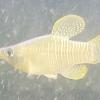Since February 2015, I have been leading a relatively large fisheries assessment on the Chattahoochee River (middle, lower), sampling twice a month for over a year until this past spring. During this time, we've come across several different DELT (deformities, eroded fins, lesions, tumors) anomalies. I've been able to identify most of the bacterial infections and parasites, but this one keeps throwing me for a loop.
We've only observed this black-colored anomaly in gizzard shad. In early stages, this black anomaly starts small, usually has a soft, fuzzy texture, and is always located near the head or back of the fish.
Attached Files
Edited by UncleWillie, 26 August 2016 - 11:55 AM.










